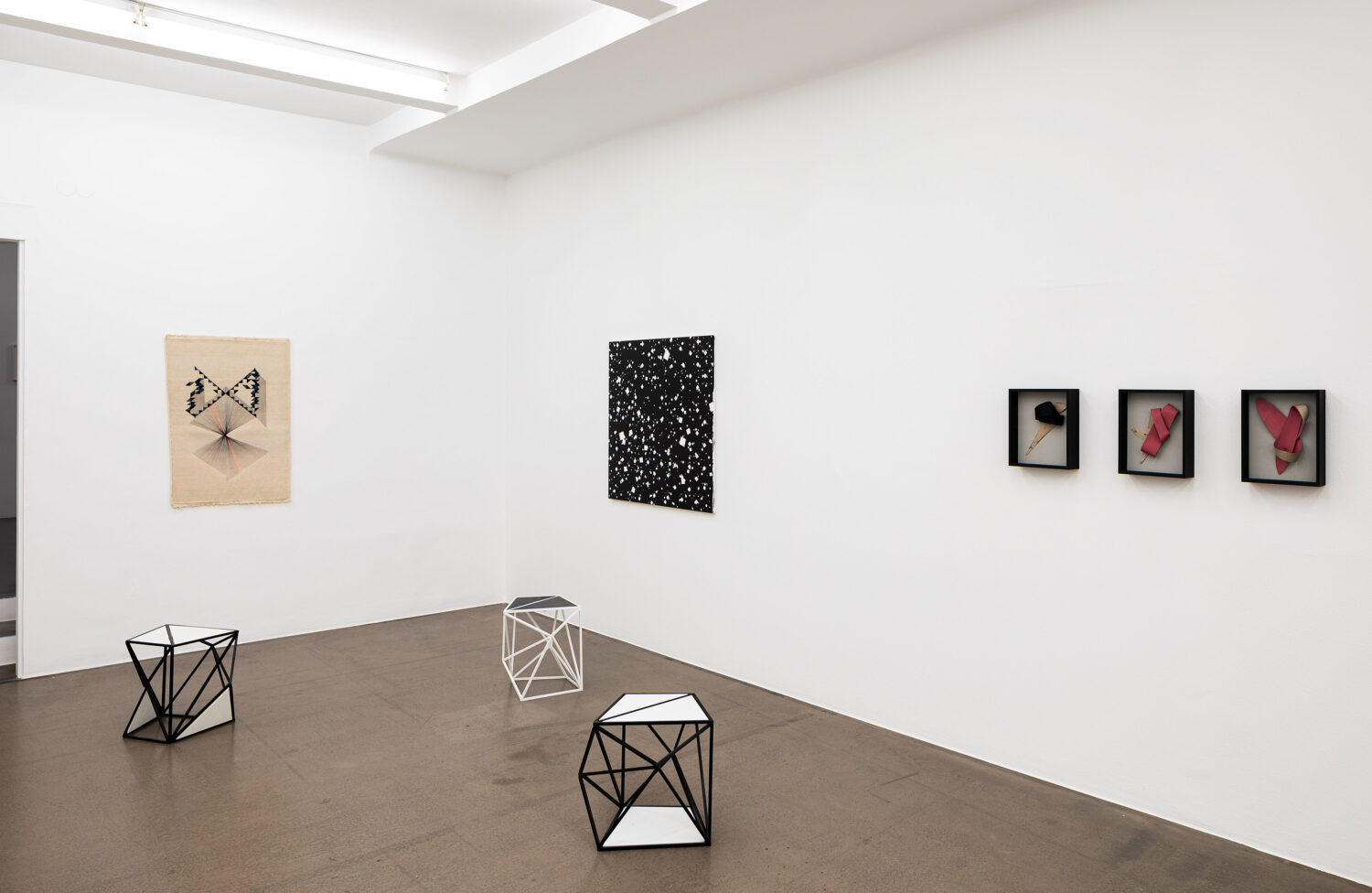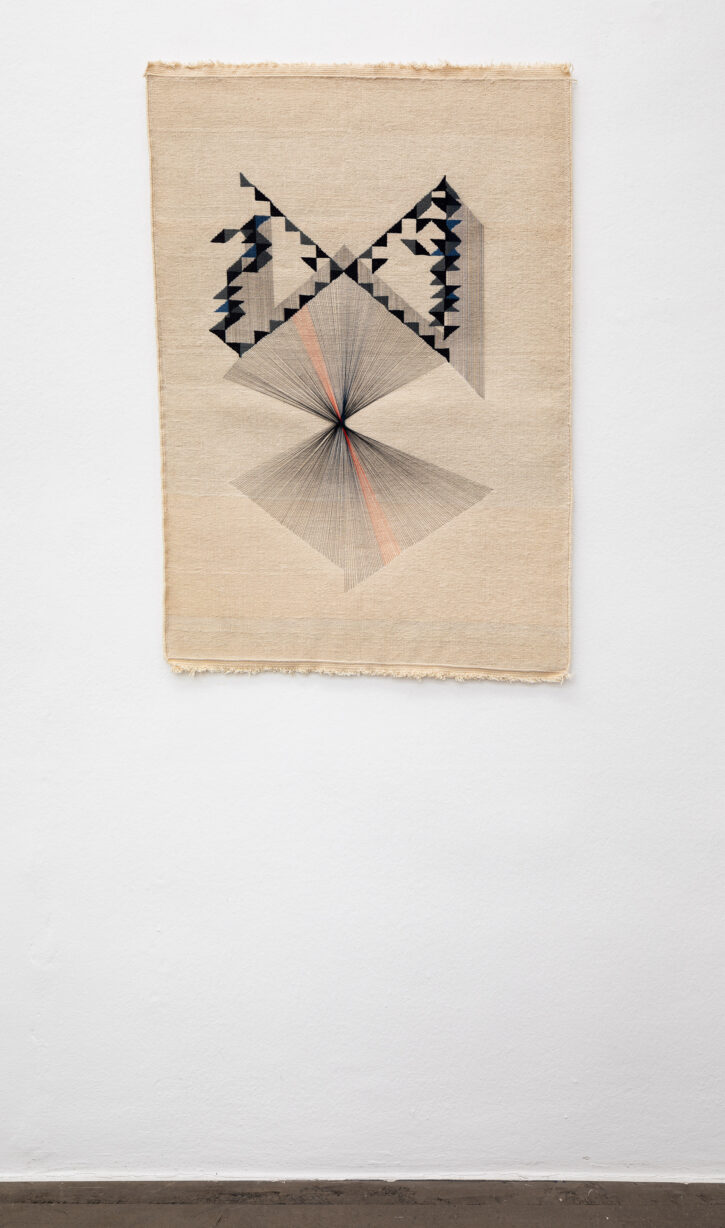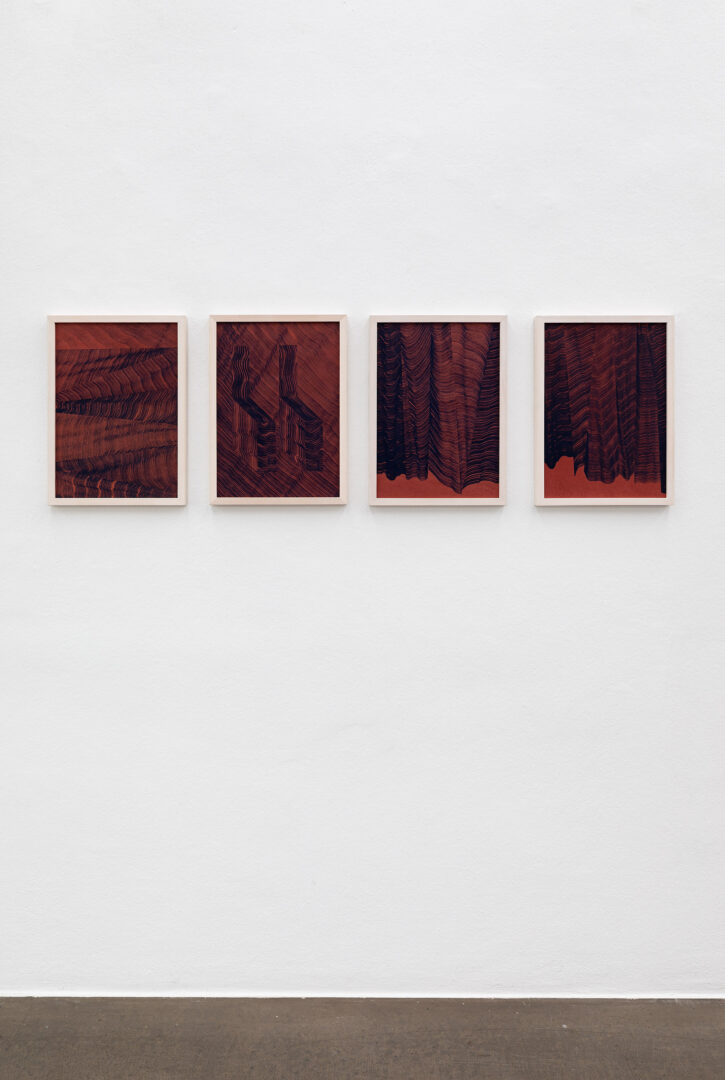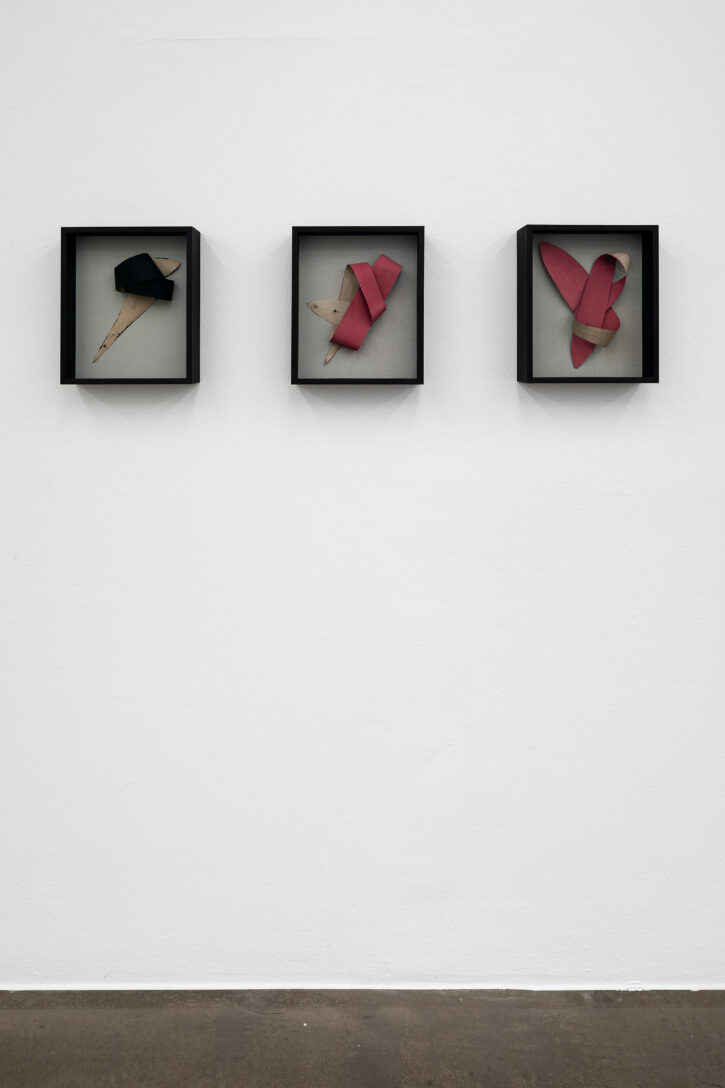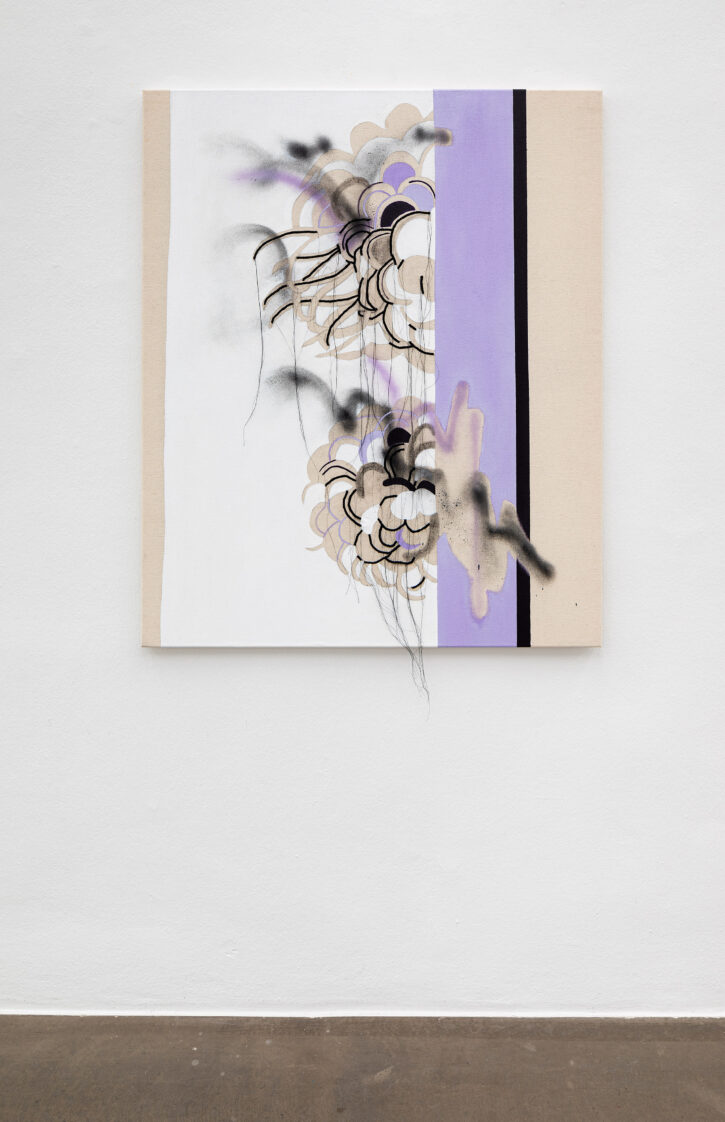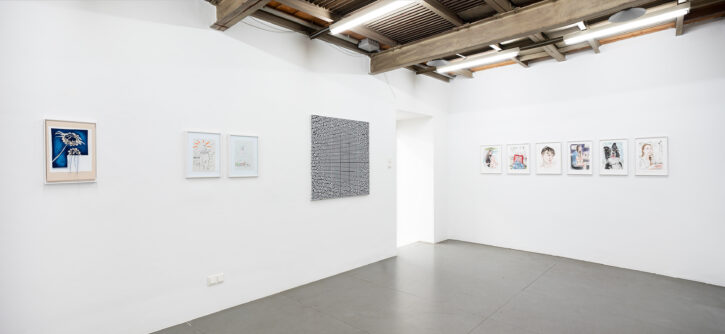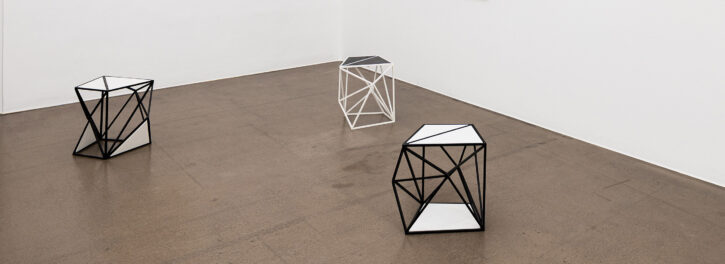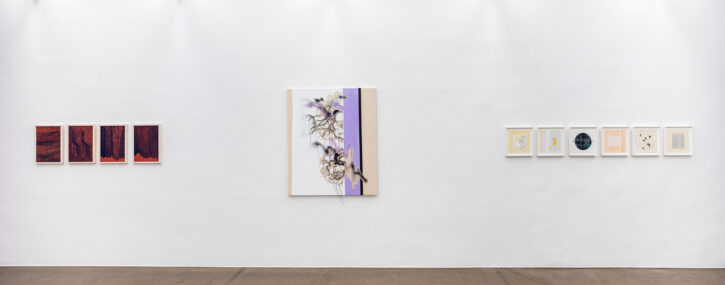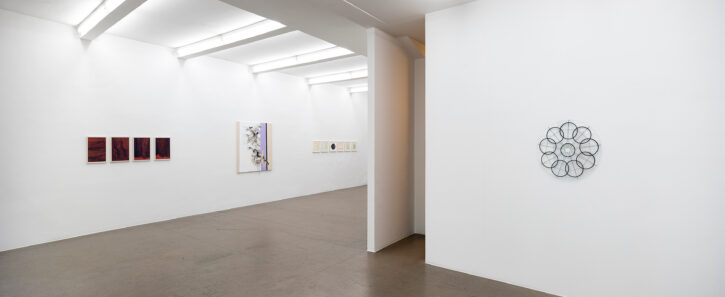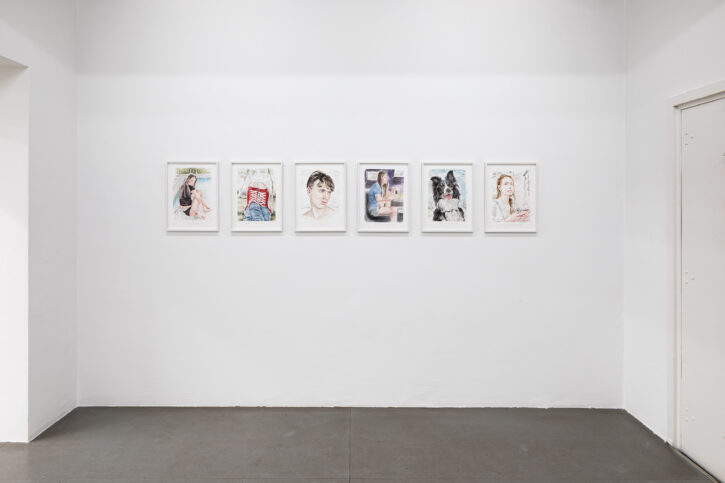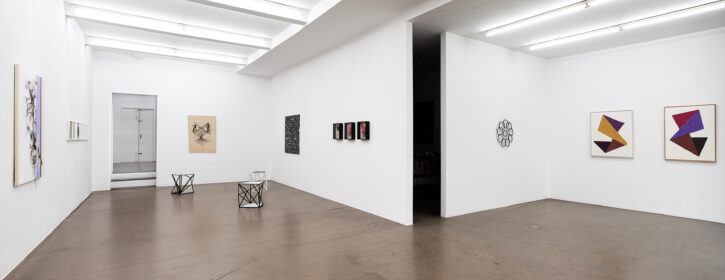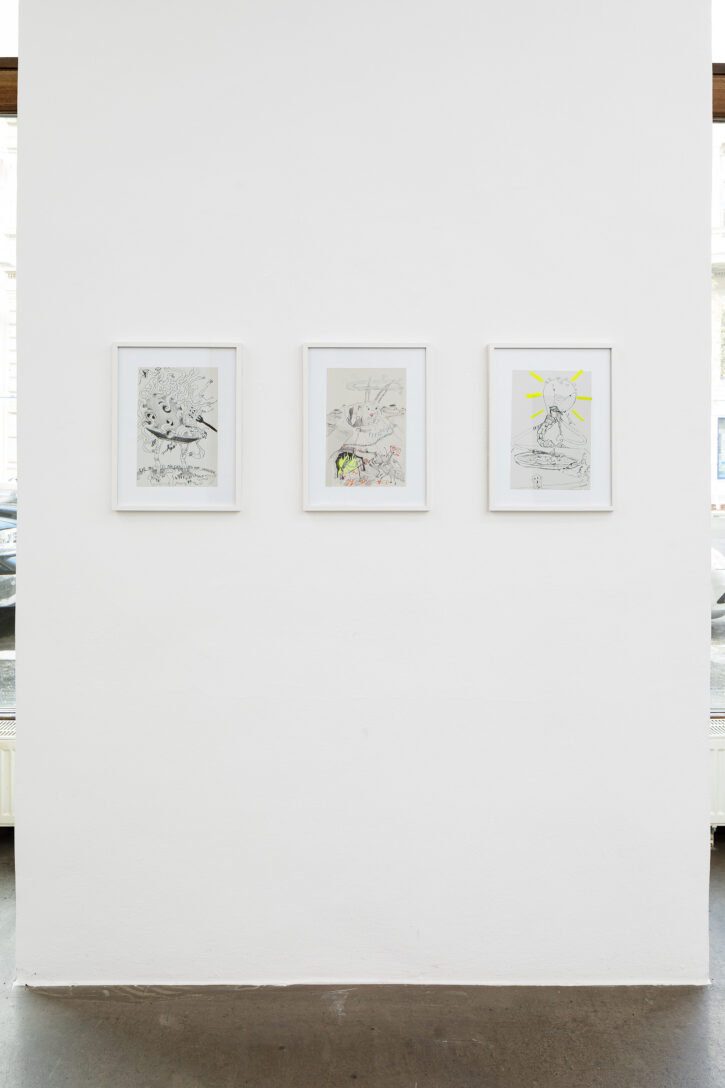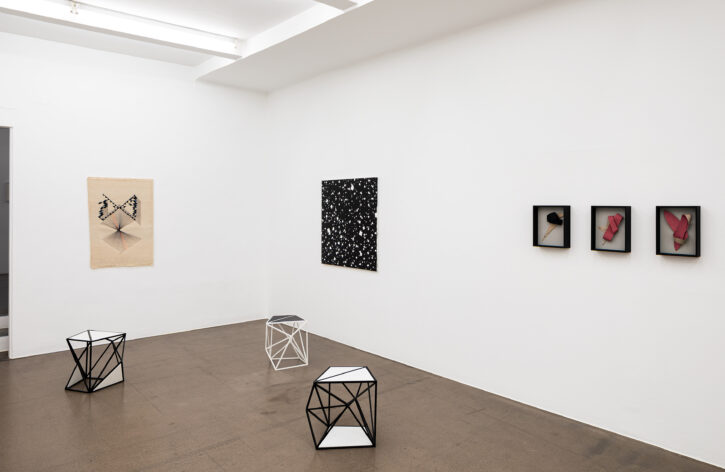About the exhibition
CAROLINE CORLEONE
Born in Erlangen, G. Lives and works in Berlin, G.
Caroline Corleone’s art touches on the fundamental painting movements of the past decades as abstract expressionism or color field painting. However, being on the pulse of time, she often finds inspiration
in post-media strategies of copying and digital montage. She likes to use fabrics, plays wildly with pat- terns, or „paints“ with her sewing machine on canvas. Her artworks draw the bow between the real, the digital, and the painted: Artificial forms of imitated nature meet urban interventions, abstract brush- strokes cross fragments and leftovers of repetitive digital patterns.
The new series of works is inspired by the textile designer Mathilde Flögl (Wiener Werkstätte). The more or less random shapes of Flögl’s textile cuts from the MAK archive (on-site research in February 2019) are the starting point for new compositions, enhanced with graphic “drawings” by sewing machine. The pattern series PPI * finds a continuation in the Flögl series, in that given patterns find form as fragmentary substitutes in blow ups as independent artistic works.
THERESA EIPELDAUER
Born 1985 in Vienna, A. Lives and works in Vienna, A
The point of departure for Jenni Tischer’s latest exhibition fortune at the Krobath Gallery was two different kinds of found objects: on the one hand, there are numerous vintage knitting needles, which the artist purchased at a warehouse sale and then turned each one of them into artfully knitted sculptures and wall objects.
The basic element in Eipeldauer’s drawings is the line, which is constantly multiplied thus preempting industrialprocesses. Reproduction techniques used since the 20th century are very present in her works. Eipeldauer also treats the transition from the individual art piece to environment in her works playfully and with artful ease. The urge to define her three-dimensional works either as an ensemble or as individual works of art automatically recedes towards the background and the decision is left to the viewers. As Heike Maier-Rieper aptly puts it, the transition from two-dimensional to three-dimensional works results in “an ambivalence between transparency and disguise”. From: Heike Maier-Rieper. “Theresa Eipeldauer.” in: 95-2015 Jubilee evn collection. Wien: Verlag für moderne Kunst, 2015.
ANNA MEYER
Born 1964 in Schaffhausen, CH. Lives and works in Vienna, A.
In her works (paintings, drawings, models, interventions in public spaces) Anna Meyer addresses modern global culture and the socio-political and feminist issues of neoliberal societies in an ironic and provocative manner.
„In the past few years, in the face of neo-liberal globalisation and the increasingly manifest climate catastrophe, painting in particular has presented itself as an aesthetic titbit, or as “a fetish and a pointless gimmick for those who would ignore the impending flood,” as the philosopher Theodor W. Adorno put it. But Anna Meyer’s paintings have never been part of this game. On the contrary, her socio-critical reflections always go hand in hand with her visual motifs and their formal implementation”. From: Raimer Stange „Nostalgia for an age yet to come“.
The current drawings in the exhibition were created in the first phase of the Corona lockdown in March 2020 and thus establish a very current reference to time.
MUNTEAN/ROSENBLUM
Born 1962 Markus Muntean in Graz, A. / Adi Rosenblum in Haifa, Israel. Collaboration since 1992.
In the compositions of their paintings and drawings, the artist couple Markus Muntean and Adi Rosenblum use methods of sampling and resampling of subjects from art history and present-day popular culture. The starting point is an intensive confrontation with the pathos formulas of art history and the questioning of how emotions that find expression as a result are articulated and interpreted in different eras. Motifs that we know from Passion cycles are applied to the psychological dispositions of contemporary existence, sometimes as the expression of an apathy that appeals to the empathy of the beholder. Historically overwhelming pictorial subjects are transferred into the present day, while at the same time triggering a discussion of the media conditions in which pictures are produced today. As a result of the use of language and lettering, a further plane penetrates into the paintings of Muntean/Rosenblum and gives insights into the complexity of the challenges which a subtle medium such as painting and drawing has to face up to today.*A new series drawings, actually presented at Krobath Wien, introduces images that have been culled from videos viewed over one hundred thousand times on YouTube, what we call viral videos. * From an article in Dicecream Mag, an Instagram magazine)
HALEH REDJAIAN
Born 1971 Frankfurt/M., G. Lives and works in Berlin, G.
Redjaian’s most recent work has been influenced by her reading of French philosopher Gaston Bachelards “The Poetics of Space” . Bachelard was a phenomenologist, holding the view that there was a dynamic interplay between an active mind and its surroundings. He undertook a systematic study, or “topoanalysis,” of the “space we love” and begins his analysis with the house, arguing that it is always more than a purely functional configuration of orthogonal planes. Embodied and affective experiences make the structural rigidity of such spaces undeniably flexible, allowing room for poetry. Redjaian approaches the grid the way Bachelard reads the house. In her drawings on paper , textile works, wall drawings and installations using thread, the grid is never entirely dominant or only functional. She deploys ready-made or hand-drawn grids and lines as a framework for her geometric elaborations. In her textile works, Redjaian takes the traditional carpets as a founding basis of a complex, multi-layered structure of threads, she carefully applies to the surface to form abstract patterns. While traditional carpets have the colored string woven into them, the artist puts them on top, semi-attached to the actual rug. By allowing irregularities and deviations within this strict order, she acknowledges the ever-present and unforeseen surprises that make up our incomprehensible lives.
ESTHER STOCKER
Born 1974 in Schlanders, IT. Lives and works in Vienna, A.
Although Esther Stocker’s works are based on geometric principles, they always have imperfections and faults. She has developed a system of geometric symbols and grids in black, white and grey, and sometimes transfers this into the third dimension, thereby modifying the surrounding space and architecture. A key theme is “presenting a functional system of the ambiguous and of the vagueness of exact forms”. She mostly integrates minimal imperfections into her works, which results in dynamic visual spaces that disrupt the perceived systematic order. The artist explains: “I need the pattern or rather the systematic order before I can create deviations from it. The absence of system can only be described through systems. It is part of the system. Behind every instance of chaos, there is always a certain kind of order.” Stocker also transfers her paintings into the three-dimensional space by bringing the mental experience of entering a painting into reality. When viewers walk into Stocker’s installations, they are in the midst of the image and can explore new dimensions by moving through it (much like the installation Stocker developed for Museum Liaunig). From: Günther Oberhollenzer. Geometrische Abstraktion, malerische Experimente und die Überwindung des Zweidimensionalen. Fair – Magazin für Kunst und Architektur, 01/2018 (English translation: Mandana Taban)
KATJA STRUNZ
1970 born in Ottweiler, G. Lives and works in Berlin, G.
Katja Strunz translates the modernist approach to time and space, to chronology and linearity into works of art, where collages and constellations of fragments of various materials enable diachronic references to past and present. In her group of works entitled “Pulp Paintings”, the traditional panel painting takes on the form of a gravitational field for hand-made paper geometrical elements, which are formally linked and yet juxtaposed in opposition to each other. The “Pulp Paintings” are, as the artist puts it, the setting for ‘temporary structures’ where it would seem the process of implementation and development has yet to be completed. They are structures of folded forms, caught in the free fall of their present pictorial state – which is possibly a sign of transition. Claudia Seidel.
SOFIE THORSEN
Born in 1971 in Århus, DK. Lives and works in Vienna, A.
Sofie Thorsen’s work examines in various work cycles modernist forms which establish three-dimensional approaches or make the dispositif of “space” the focal point of reflection. Interventions into real space or visual representations of this space in Thorsen’s works redefine the architectural parameters and constructions related to those parameters. The collages, assemblages and the latest relief-paintings are the result of her work, over several years, with Japanese room-divider screens, kimonos as well as the art of folding. She uses the tradition of Japanese decorative arts contain clear architectonic elements.
JENNI TISCHER
Born in G. Lives and works in Berlin.
Crucial to the design of the three-dimensional works cre- ated by Jenni Tischer is the combination of material, colour, form and text. The artist incorporates references to modernism into the context of her own works, while undermining them at the same time. Her installations re- semble stage sets, in which a wealth of objects seem to be telling stories, an impression contradicted by the fact that they preclude interpretation. Political concerns such as authorship, production and feminism resonate in Tischer‘s works, specifically in her choice of technique. She often exploits typically feminine activities like em- broidery, sewing or weaving, which she transports into the context of art with great subtlety. Text: From: Baloise Art Prize 2013.
In the works titled Decision Making, Tischer combines black looms of various sizes to form various “fabrics” which are reminiscent of the church window patterns. The yarn holds together the looms that, in turn, are “framed” by the glass pane. The result is a convolution of “image” and “frame”, of display and work of art. So it’s not only the process of “making”, as the title suggests, and the decisions involved, that are, literally, “on display” here. But also the technique of hanging the art pieces is made visible: there is a small hole at the centre of the glass pane for the nail it is hanging on.Text: Fiona McGovern Translation: Mandana Taban.
Further informations:
